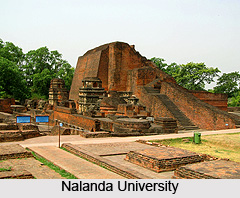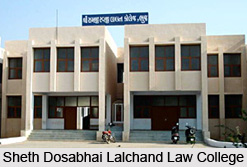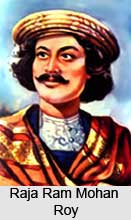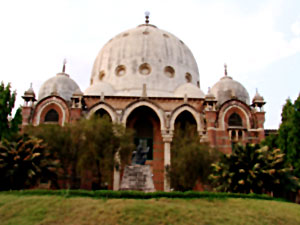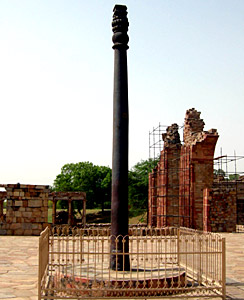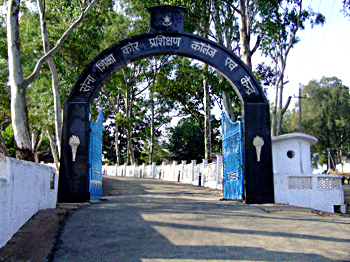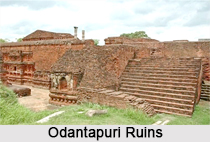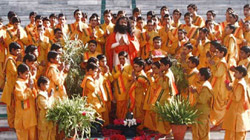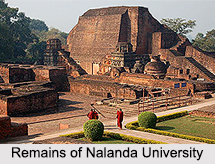Introduction
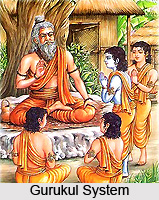 Education in ancient India had a deep impact in the upliftment and advancement of the early society and over all development. India is pregnant with a rich tradition of knowledge and learning from the earliest days of Indian civilization. There are several literary sources, such as the Vedas and other Hindu texts and scriptures, which offer references about education system of the ancient societies. The Mahabharata, some Dharma sutras, particularly those of Gautama Buddha and Apastamba and the Manu Smriti, are the principal works dealing with the system of education in ancient India.
Education in ancient India had a deep impact in the upliftment and advancement of the early society and over all development. India is pregnant with a rich tradition of knowledge and learning from the earliest days of Indian civilization. There are several literary sources, such as the Vedas and other Hindu texts and scriptures, which offer references about education system of the ancient societies. The Mahabharata, some Dharma sutras, particularly those of Gautama Buddha and Apastamba and the Manu Smriti, are the principal works dealing with the system of education in ancient India.
History of Education in Ancient India
From the Vedic to the Brahman period, literature and additional literature sustained to be created. Even in the Brahman period, education continued to be looked upon as the means to knowledge. It has the same objectives that Vedic education had. However, with the passage of time and a change in the needs of society, the importance attached to them underwent a change. In this period, the following objectives were ascribed to education.
1. Self-control
2. Development of character
3. Generation of sociability or social awareness
4. Integral development of personality
5. Propagation of purity
6. Preservation of knowledge and culture.
Education in this age was unrelenting to carry on the foundations offered to it during the Vedic period, but a certain firmness and narrowness now marked its implementation. Education now aimed at equipping the student for the struggle for existence. After the "Upanayana" or introduction ceremony, teachers imparted education to their students according to the latter`s interests, tendencies and nature. Celibacy was rigidly observed by the students. Teachers paid full attention to the psychological make-up of their students while teaching. Corporal or physical punishment was regarded as the last resort of administration and discipline. It has been stated in the Manu Smriti and Yajyavalka.
Gurukul System
Education in Ancient India originated with the Gurukul system. This type of ancient Hindu school in India was residential in nature with the Shishyas or students and the Guru or teacher living in proximity within the same house. The students resided together irrespective of their social standing. However, several temples and community centers regularly took the role of schools. In addition to that ancient Indian education achieved a noticeable position in the early Vedic period, beginning in the 1200 B.C. In the Vedic days, the teaching of the four Vedas, the hymns and ritual practices were seen.
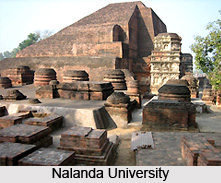 The Vedas included the Sanskrit language which in turn became the language of classical learning. Besides the pronunciation of the Vedas and their implication, phonology, metrics, elementary grammar, and etymology were also taught. Though, the Vedic education was not transmitted to people of low strata, yet the Vedic system inspired the modern day education system. The school in the ancient education system lasted for 7 to 8 hours a day. In fair weather; classes were held under the shelter of the tree. In the rainy season schools ran under thatched roof. Temple colleges of the past had been of great renown for having spacious buildings for classrooms and the residential complexes of the students and the "Gurus". Gurukuls and Ashrams were generally situated on the river banks or on the lake to attain the knowledge.
The Vedas included the Sanskrit language which in turn became the language of classical learning. Besides the pronunciation of the Vedas and their implication, phonology, metrics, elementary grammar, and etymology were also taught. Though, the Vedic education was not transmitted to people of low strata, yet the Vedic system inspired the modern day education system. The school in the ancient education system lasted for 7 to 8 hours a day. In fair weather; classes were held under the shelter of the tree. In the rainy season schools ran under thatched roof. Temple colleges of the past had been of great renown for having spacious buildings for classrooms and the residential complexes of the students and the "Gurus". Gurukuls and Ashrams were generally situated on the river banks or on the lake to attain the knowledge.
Role of Teachers in Ancient Indian Education
The preceptors were of two classes, namely Acharya and Upadhyaya. According to ancient literary texts the Acharya performs the Upanayana ceremony of the students, teaches him the Veda along with ritualistic literature and the Upanishads. But he does not work for the pupil for livelihood whereas the Upadhyaya teaches his pupil the Veda and the Vedic literatures for livelihood. The Apastamba Dharma Sutra proclaims that though the teacher is the sole guardian of the learner during his study, yet he cannot exercise arbitrary power. It declares that the educator cannot utilise the pupil`s services for his own advantage. For the student`s offences, he can punish him in the prescribed manner but not in any way he likes.
According to the Apastamba-dharma sutra, a pupil should confidentially draw the attention of the teacher to any wrongdoing of the rules, meant for him, either purposely or unconsciously. The students are allowed to control the teacher by force from wrong-doing or to get him restrained by his father etc. Mahabharata mentions that students are allowed to desert his teacher who is arrogant, ignorant of his duty and resorts to a wrong course of action.
Brahmacharya System
Brahmacharya summarises the sum total of the responsibilities of a student. It entails rigorous self-discipline and self-control. All sorts of pleasures and luxuries must be avoided by the pupils. Some of the occasions on which termination of study was prescribed include dusty storm by day, playing of certain musical instruments within the hearing of the pupil, cries of animals, screech of an owl, heavy downpour, rattling of thunderbolt, earthquake, eclipse, fall of a meteor, festival, certain Tithi and Nakshatras, e.g. full moon day, etc. Samavartana marks the end of a pupil`s period of study and return home. According to some literary sources, education in ancient India was not confined only to the privacy of the preceptor`s house. In matters of education in ancient societies, the constricted barriers of the caste-system seemed to have crumbled down as per the various literary texts. The spread of Buddhism and Jainism in India enriched and evolved the state of education in ancient India. In this period education became accessible to everyone and various celebrated educational institutions were established at that instant. Few of the most important universities of India in the ancient times were Vikramshila, Taxila (Takshashila) and Nalanda.
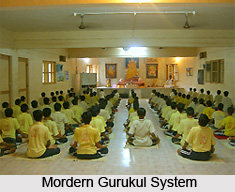 Education at that time was free. It was free because no student was required to pay any fees. It was free also because no outside agency could interfere in the matters of education. There was perfect autonomy. No external authority no external beneficiary, no politics was permitted to enter the school or college system. A student had to pay nothing in return for education he received in a Gurukul or Ashram. Access to good education depended not on wealth but on talent. The student was expected, if desired but never compelled to offer a field, cow, horse or the elements of the daily needs to his teacher according to his financial position in the society. Education could not be bought one could go up the ladder as his abilities permitted. Some of the best known universities in India are Ancient Nalanda University, Takshashila University, Odantapuri in Bihar, (500 to 1040), Somapura in Bangladesh, Jagaddal in Bengal (now in West Bengal), Nagarjunakonda in Andra Pradesh, Vikramshila in Bihar, Saradhha peeth in Kashmir, Valabhi in Gujarat (from Maitrak period), Varanasi in Uttar Pradesh, Kanchipuram in Tamil Nadu, Manyakheta in Karnataka, Puspagiri and Ratnagiri in Orissa.
Education at that time was free. It was free because no student was required to pay any fees. It was free also because no outside agency could interfere in the matters of education. There was perfect autonomy. No external authority no external beneficiary, no politics was permitted to enter the school or college system. A student had to pay nothing in return for education he received in a Gurukul or Ashram. Access to good education depended not on wealth but on talent. The student was expected, if desired but never compelled to offer a field, cow, horse or the elements of the daily needs to his teacher according to his financial position in the society. Education could not be bought one could go up the ladder as his abilities permitted. Some of the best known universities in India are Ancient Nalanda University, Takshashila University, Odantapuri in Bihar, (500 to 1040), Somapura in Bangladesh, Jagaddal in Bengal (now in West Bengal), Nagarjunakonda in Andra Pradesh, Vikramshila in Bihar, Saradhha peeth in Kashmir, Valabhi in Gujarat (from Maitrak period), Varanasi in Uttar Pradesh, Kanchipuram in Tamil Nadu, Manyakheta in Karnataka, Puspagiri and Ratnagiri in Orissa.
Education in Medieval India
Medieval period witnessed a radical transformation in the Indian subcontinent. The country was invaded by various foreign rulers and several traders from around the world came and settled in the country. The tradesmen and the invaders brought with them their own cultures and intermingled with the people of the each district of the state. Besides, religion, society and culture, Education in medieval India also experienced a new perspective. The Mughal rulers came to India and established their rule. In the 11th century the Muslims established elementary and secondary schools. Furthermore, this led to the commencement of universities at cities like Delhi, Lucknow and Allahabad. Education developed with a fresh aspect during that period as there was an excellent interaction between Indian and Islamic traditions in all fields of knowledge like theology, religion, philosophy, fine arts, painting, architecture, mathematics, medicine and astronomy.
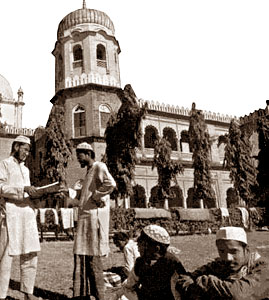 However, before the advent of the Muslims in India, there was a developed system of education, but Education in medieval India was shaped with the founding of the institutions of learning. Muslim rulers promoted urban education by bestowing libraries and literary societies. They founded primary schools (maktabs) in which students learned reading, writing, and basic Islamic prayers, and secondary schools (madrasas) to teach advanced language skills In India. Several Madrasahs were set up by Sultans, nobles, and their influential ladies. The main objective of these Madrasahs was to train and educate scholar who would become eligible for the civil service as well as performing duties as judge. Iltutmish was the first ruler to establish a Madrasahs at Delhi during the medieval rule. Gradually many Madrasahs came into being.
However, before the advent of the Muslims in India, there was a developed system of education, but Education in medieval India was shaped with the founding of the institutions of learning. Muslim rulers promoted urban education by bestowing libraries and literary societies. They founded primary schools (maktabs) in which students learned reading, writing, and basic Islamic prayers, and secondary schools (madrasas) to teach advanced language skills In India. Several Madrasahs were set up by Sultans, nobles, and their influential ladies. The main objective of these Madrasahs was to train and educate scholar who would become eligible for the civil service as well as performing duties as judge. Iltutmish was the first ruler to establish a Madrasahs at Delhi during the medieval rule. Gradually many Madrasahs came into being.
The system of Education in medieval India was under the control of Ulama who were in favour of curriculum as laid down by Akbar. During those days education was related to religious training. However, various subjects such as medicine, Arabic literature, grammar and philosophy were also taught. History states that Arab and Central Asian peoples brought Muslim educational models to the India in both the medieval and early modern periods. Women education in India during the medieval period was prevalent.
Muslim girls of affluent families studied at home and moreover, as Persian was the court language of the period, elite boys could attend Persian schools to learn literature, history, ethics, law, administration.
Education in medieval India flourished mostly during the Mughal rule from the beginning of 1526 until the end of Mughal political presence in 1848. In the later medieval era, the British came to India and introduced English education. With the coming of the European missionaries, Western education made firm advances in the country. Various universities and thousands of colleges got affiliated and popularity of education increased in the medieval period.
Education under the Bahamanis
In the Bahmani period the education system had its unique style. At that time, the main learning centres were Nasik, Paithan, Gangapur and Salotgi. The main study matter used to be the Vedic learning and it was regarded as the highest stage of learning during the Bahmani period. The students used to go to the houses of the scholars and learned pundits to take teachings under their direct supervision.
The Bahmani education curriculum included the study of Amara Koslia, Rupavati, Samskara, Panchtantra, Hitopadesha, and the works of Kalidasa. One could also take lessons on advanced studies such as logic, philosophy and grammar. Many scholars and pundits flourished during the Bahmani period. Few of them are Trivikrama Barat, Rameshwara Bhatt, Kamalkar Bhatt, Keshava and Ganesh Daiwadnya.
During the Bahmani period, the Muslim schools were usually attached to mosques. Those who were interested to take higher studies went to the madrasas and also to the residences of the scholars. Here one could learn the Arabic grammar and language as well as the Quran and the Hadis. Calligraphy was also taught in these schools. The Muslim students used to go to the places like Gulbarga, Bidar, Kandhar, Elichpur, Daulatabad, Junnar, Chaul and Dabhol for taking teachings during Bahmana Kingdom. One of the main centres of Muslim learning was Mahmud Gawan`s big madrasa at Bidar.
The biggest institute of the Muslim learning during the time of Bahmani was Dar-ul-ulum at Elichpur (Berar). This institute used to receive a grant of 3000 dinars annually. And the best thing was that all the Bahmani Sultans was literate and they promoted learning. One of them was Muhammad Shah II, who had done a lot to promote learning at that time. Many scholars including the great Persian poet Hafiz Shiraz got respected position in his court. This tradition was continued by Firuz Shah. Then many schools were established by Muhammad Shah III also and his minister Mahmud Gawan ably assisted him.
During the Bahmani period, Telugu literature also flourished a lot and the evidence of it can also be found. Many scholars, poets and philosophers enriched the Telugu literature by their compositions. Some of the great scholars and their great works of the Bahmani period include `Srinagara Naishadha` by Srinatha, `Bhagavatha Purana` by Bammera Potana (1400-75), `Vikra-Mana-Charitra` by Perma Raja, `Naicketopakhyana` by Daggupalli Duggaya, and `Panchatantra` of Dubagunta Narayana.
But the Bahmani period did not have any centre for technical training. The common practice was to transfer the knowledge from generation to generation. The father used to pass his knowledge to the son. Architecture, sculpture, medicine, arts and crafts, weaving and many other arts continued to flourish this way.
Few of the significant Persian literary works under the patronage of the Bahmani Sultans include the `Sir a jut Tawarikb` by Muhammad Lari, `Tuhfatus Salatin` by Mulla Dawud of Bidar and `Tarika-i-Muhammad Shahi` of Mulla Abdul Karim Hamadani.
The literature on Sufism and mysticism also developed during the Bahmani period. A number of works including Kitab-ul-Khatima, Jawami-ul-Kalim, and Amsarul Asrar were composed by the great saint Banda Nawaz. The other valuable works consist of the famous Manazirul-Insha and Riyaz-ul-Insha by Mahmud Gawan. The first one is written on the art of Persian epistolography while the second one is a collection of letters written by Gawan and the Bahmani Sultans of kings, scholars, poets and other eminent persons. Few of his letters contained Arabic verses. Even the translation of a Sanskrit work on veterinary science was done into Persian and was entitled `Tarjma-I-Salbutar`.
The Arabic literature also got the patronage of the Bahmani kings. The kings were very knowledgeable e, g, Firuz Shah was a scholar of Arabic and used to give lectures on logic, mathematics, geometry, etc. The well-known scholars, who got the support of the Bahmani kings, include Sadrush Sharif Samarquandi, Muhammad Badakshi, Saikh Burhan-ud-din and Shaikh Siraj-ud-din Junadi. Banda Nawaz wrote a number of works in Arabic particularly a commentary on Quran, which achieved the title `Unimul Maani`, besides glosses on `Tafsir Kashsbafznd Mashariqu-l-Anwar`. Shaikh Ala-ud-din also composed Fiqb Makhdutni, Tafsir-I-Mabaimi, Adillat-ul-Tawhid, etc.
Literature and education during Harsha`s reign
 In the field of literature and education many significant changes had taken place during Harsha`s reign. Education had made a remarkable progress during this period. Educational centers were also opened along with the Buddhist monasteries and other religious centers. Most of these centers were situated in Kannauj, Monghyr, Manikpur, Gaya etc. Nalanda University had reached the zenith of its glory and significance in Harsha`s period. Besides, religion, other subjects such as philosophy, medical science etc. were also taught. The educational system was to a great extent has on arguments and debates. The standards of the students of Nalanda were very high.
In the field of literature and education many significant changes had taken place during Harsha`s reign. Education had made a remarkable progress during this period. Educational centers were also opened along with the Buddhist monasteries and other religious centers. Most of these centers were situated in Kannauj, Monghyr, Manikpur, Gaya etc. Nalanda University had reached the zenith of its glory and significance in Harsha`s period. Besides, religion, other subjects such as philosophy, medical science etc. were also taught. The educational system was to a great extent has on arguments and debates. The standards of the students of Nalanda were very high.
The number of student coming from foreign countries to study at Nalanda included considerably larger number of Chinese students. About hundred Chinese travelers came to receive education at Nalanda.
Besides Nalanda, Ujjain was another important centre of education where especially astrology and mathematics were taught. Taxila was also an important centre of education. Besides these universities, education was imparted in many other centers.
King Harsha was himself a great poet and dramatist; the three dramas `Priyadarshika,` `Ratnavali` are attributed to him.
The famous literary works, `Harshacharit` and `Kadambari` were written by Bana during Harsha`s period. Great power Bharavi and the famous scholar Shilabhadra were also there during his reign. Achraya jayasena was also in the court of Harsha.
Thus there had been a great progress in the field of literature and education during Harsha`s period, and it is due to this that this period occupies an important position in the history of India. It is on account of this feature that this age has been praised by different scholars. Hiuen Tsang was astonished and very much impressed to see the progress of education and literature in those days.
Education in India during Pratihara period
The literary works of Rajasekhar throw a flood of light upon the education of that period. Rajasekhar has referred to three classes of students who studied 14 subjects. The first class of students learnt things once. Then in the second class there were students who learnt things by practice. These were called ahara buddhi. Then lastly there were students who could not learn even after practice and students were never able to receive education.
Besides the 14 subjects students were also given the education of agriculture, commerce, sculpture, criminal law i.e. danda niti and literature. The Pratihara kings patronized the scholars. For example scholars like Rajasekhar and Khemishwara received royal support and patronage of the Pratihara kings. During the period the Pratiharas, Nalanda, Vaiiabhi, Pataliputra, Ujjaini, Kampilya and Vikramashila were the prominent centres of education and learning.
In the field of literature, the most prominent literary figures of this period are Rajasekhar and Khemishwara. Some of the works of Rajasekhar are still available. His best creation is `Karpura manjari` which he wrote at the request of his wife Avanti Sundari. `Viddasal manjika`, `bala bharat`, `kavya mimansa` are some of his other work among of the poems of Rajasekhar.
